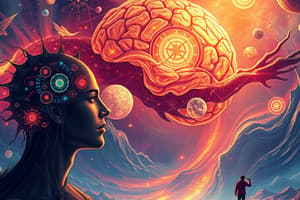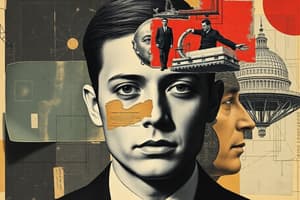Podcast
Questions and Answers
According to the Cannon-Bard theory of emotions, what occurs simultaneously due to the stimulus?
According to the Cannon-Bard theory of emotions, what occurs simultaneously due to the stimulus?
- Bodily arousal
- Past experience and situational cues
- Emotional feelings and bodily arousal (correct)
- Emotional feelings
What is the primary focus of Schachter's Cognitive Theory of emotions?
What is the primary focus of Schachter's Cognitive Theory of emotions?
- The role of thalamus in emotional feelings
- The importance of facial expressions in emotional feelings
- The perception of bodily arousal according to past experience and situational cues (correct)
- The drive-reduction theory of motivation
What is the main idea behind the Model of Emotion by Lazarus?
What is the main idea behind the Model of Emotion by Lazarus?
- Facial expressions and emotional feelings do not contradict with each other (correct)
- Past experience is the primary factor in emotional feelings
- Facial expressions contradict with emotional feelings
- Emotional feelings are separate from bodily arousal
What is the drive-reduction theory of motivation based on?
What is the drive-reduction theory of motivation based on?
What is the primary difference between extrinsic and intrinsic motivation?
What is the primary difference between extrinsic and intrinsic motivation?
According to the Arousal Theory, what is the optimal level of arousal for performance?
According to the Arousal Theory, what is the optimal level of arousal for performance?
What is the primary focus of motivation?
What is the primary focus of motivation?
What is the incentive theory of motivation based on?
What is the incentive theory of motivation based on?
What is the main purpose of setting challenging, specific, and attainable goals?
What is the main purpose of setting challenging, specific, and attainable goals?
What is an ill-defined problem?
What is an ill-defined problem?
What is the first step in the problem-solving process?
What is the first step in the problem-solving process?
What is functional fixedness?
What is functional fixedness?
What is the purpose of using the 'working back' heuristic in problem-solving?
What is the purpose of using the 'working back' heuristic in problem-solving?
What is the main characteristic of an algorithm in problem-solving?
What is the main characteristic of an algorithm in problem-solving?
What is the main purpose of standardization in test construction?
What is the main purpose of standardization in test construction?
What is intelligence in the context of psychology?
What is intelligence in the context of psychology?
What are the characteristics of a stressor?
What are the characteristics of a stressor?
What is the primary appraisal of a stressor concerned with?
What is the primary appraisal of a stressor concerned with?
What is the physical response to short-term stress?
What is the physical response to short-term stress?
What is the third stage of the General Adaptation Syndrome?
What is the third stage of the General Adaptation Syndrome?
Which of the following is an environmental factor that can cause stress?
Which of the following is an environmental factor that can cause stress?
What type of conflict involves choosing between two appealing options?
What type of conflict involves choosing between two appealing options?
What is a characteristic of a Type A personality?
What is a characteristic of a Type A personality?
What can lead to burnout and workaholic behavior in the workplace?
What can lead to burnout and workaholic behavior in the workplace?
What is a factor that can help people cope with stress in the workplace?
What is a factor that can help people cope with stress in the workplace?
What is a way to improve stress-coping in the workplace as a manager?
What is a way to improve stress-coping in the workplace as a manager?
What is a characteristic of a Hardiness personality?
What is a characteristic of a Hardiness personality?
What can a manager do to reduce role ambiguity and role conflict in the workplace?
What can a manager do to reduce role ambiguity and role conflict in the workplace?
What is the primary reason that 65% of teachers in Milgram's study continued to obey the orders to deliver electric shock on students?
What is the primary reason that 65% of teachers in Milgram's study continued to obey the orders to deliver electric shock on students?
In Milgram's study, what was the percentage of teachers who obeyed the rule when they performed the experiment in a small town office?
In Milgram's study, what was the percentage of teachers who obeyed the rule when they performed the experiment in a small town office?
What is the phenomenon where individuals tend to perform better in the presence of other people?
What is the phenomenon where individuals tend to perform better in the presence of other people?
What is the term that refers to people losing their sense of self-awareness and performing undesirable behavior when in a group?
What is the term that refers to people losing their sense of self-awareness and performing undesirable behavior when in a group?
What is the primary reason for social loafing?
What is the primary reason for social loafing?
What is the effect of having another teacher as a role model on the obedience rate?
What is the effect of having another teacher as a role model on the obedience rate?
What is the effect of disagreement between two experimenters on the obedience rate?
What is the effect of disagreement between two experimenters on the obedience rate?
What is the phenomenon where people tend to avoid taking responsibility for actions because they assume others will do so?
What is the phenomenon where people tend to avoid taking responsibility for actions because they assume others will do so?
Flashcards are hidden until you start studying
Study Notes
Emotions and Motivation
-
Cannon-Bard Theory of emotions: the activation of the thalamus due to a stimulus provides emotional feelings and bodily arousal simultaneously.
-
Schachter's Cognitive Theory of emotions: the perception of bodily arousal according to past experience and situational cues provides emotional feelings and behavioral responses.
-
Model of Emotion (by Lazarus): facial expressions and emotional feelings do not contradict each other.
-
Motivation: a set of internal and external factors that energize our behavior and lead us to our goal.
-
Model of motivation: a process that initiates, sustains, and directs activities.
-
Drive-reduction theory: needs produce drive, drive produces motivated behaviors to obtain the goal to eliminate the need, resulting in a balanced internal state.
-
Incentive theory: pulled by incentives, does not require drive-reduction.
-
Arousal Theory: our behavior is motivated to obtain a certain level of arousal, which affects our performance level.
-
Extrinsic motivation: motivated by external reinforcement and to avoid bad stimuli.
-
Intrinsic motivation: motivated by self-enhancement and personal growth.
-
Setting goals that are challenging, specific, and attainable can boost confidence.
Problem-Solving
- Problem: when people do not know how to reach a goal when there is a goal.
- Types of problems: ill-defined problems (lack clear specification of method) and well-defined problems (clear specification of starting point, destination, and method).
- Problem-solving steps: interpreting the problem and trying to solve the problem.
- Blocks in solving problems: interpretation blocks (fixation, functional fixedness) and strategy blocks (over-reliance on past experience and previously successful solving strategy).
- Problem-solving strategies: algorithm (step-by-step solving method) and heuristic (relying on past experience in solving similar questions).
Thinking and Intelligence
- Thinking: the process of processing information to solve problems, make judgments, and decisions.
- Intelligence: refers to problem-solving skills and cognitive abilities.
Elements of a Good Test in Psychology
- Standardization: distributing the test to a large number of representative populations to obtain the test score and 'test norm'.
Stress and Coping
- Reaction to stress: short-term stress ("fight or flight response"), long-term stress (General Adaptation Syndrome: alarm reaction, resistance, and exhaustion).
- Sources of stress: environmental factors, psychological factors, conflicts, change, and pressure.
- Personality and stress-coping: Type A personality (more easy to get angry, competitive, perfectionist), Type B personality (more relaxed), and Hardiness personality (take control of their lives, treat stressors as challenges).
Stress in the Workplace
- Role ambiguity (unclear and not specific job responsibilities) and role conflict (unbalance between job requirement and personal expectations) can lead to burnout and workaholic.
- Factors of people in coping with stress in the workplace: hardiness, organizational-based self-esteem, and negative affectivity.
- Ways to improve stress-coping in the workplace as a manager: two-way communication, allowing employee control, defining roles, offering stress management programs, and eliminating role ambiguity and role conflict.
Obedience and Conformity
- Obedience: a change in behavior that is ordered by the authority directly.
- Milgram's study in obedience to authority: 65% of teachers continued to obey the order and apply the maximum 450 voltage on students.
- Factors influencing obedience: teacher responsibility, experimenter unanimity, and proximity to the student.
Social Influence
- Social facilitation: individuals tend to perform better in the presence of other people.
- Social loafing: people tend to make less effort to achieve their goal when working in a group.
- Deindividuation: people lose their sense of self-awareness and perform undesirable and antisocial behavior when in a group.
Studying That Suits You
Use AI to generate personalized quizzes and flashcards to suit your learning preferences.




